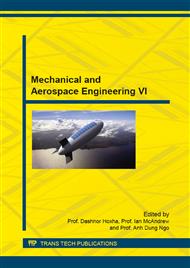p.571
p.576
p.582
p.589
p.596
p.602
p.609
p.615
p.622
A Simple and Robust Subsonic Boundary Layer Method to Be Used with the Panel Method for Wing Calculations Using a Wing Strip Approach
Abstract:
This paper will present the development of a simple subsonic boundary layer method suitable to be used coupled with panel methods in order to estimate the aerodynamic characteristics, including viscous drag and maximum lift coefficient, of 3D wings. The proposed method does not require viscous-inviscid iterations and is based on classical integral bi-dimensional boundary layer theory using Thwaites and Head ́s models with bi-dimensional empirical corrections applied to each wing strip being therefor robust and efficient to be used in the early conceptual stage of aircraft design. Presented results are compared to the Modified CS Method in an IBL scheme and experimental data and are shown to provide good results.
Info:
Periodical:
Pages:
596-601
Citation:
Online since:
October 2015
Keywords:
Price:
Сopyright:
© 2015 Trans Tech Publications Ltd. All Rights Reserved
Share:
Citation:


